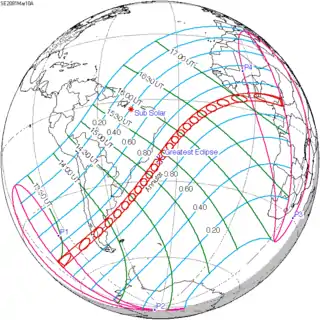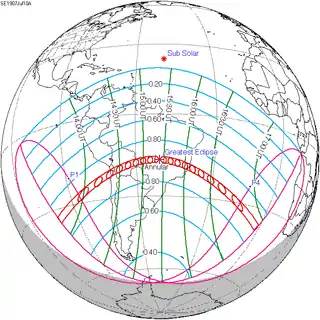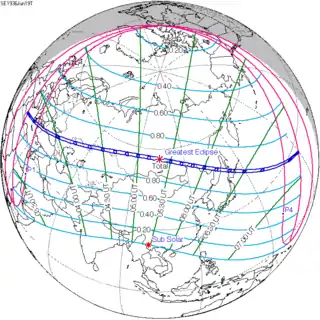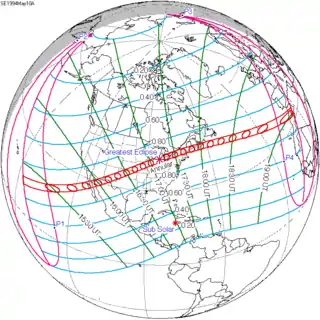| Solar eclipse of March 10, 2081 | |
|---|---|
 Map | |
| Type of eclipse | |
| Nature | Annular |
| Gamma | −0.3653 |
| Magnitude | 0.9304 |
| Maximum eclipse | |
| Duration | 456 sec (7 m 36 s) |
| Coordinates | 22°24′S 36°42′W / 22.4°S 36.7°W |
| Max. width of band | 277 km (172 mi) |
| Times (UTC) | |
| Greatest eclipse | 15:23:31 |
| References | |
| Saros | 131 (54 of 70) |
| Catalog # (SE5000) | 9689 |
An annular solar eclipse will occur on Monday, March 10, 2081. A solar eclipse occurs when the Moon passes between Earth and the Sun, thereby totally or partly obscuring the image of the Sun for a viewer on Earth. An annular solar eclipse occurs when the Moon's apparent diameter is smaller than the Sun's, blocking most of the Sun's light and causing the Sun to look like an annulus (ring). An annular eclipse appears as a partial eclipse over a region of the Earth thousands of kilometres wide.
Related eclipses
Tritos
- Preceded: Solar eclipse of April 11, 2070
- Followed: Solar eclipse of February 7, 2092
Tzolkinex
- Preceded: Solar eclipse of January 27, 2074
- Followed: Solar eclipse of April 21, 2088
Solar eclipses 2080–2083
This eclipse is a member of a semester series. An eclipse in a semester series of solar eclipses repeats approximately every 177 days and 4 hours (a semester) at alternating nodes of the Moon's orbit.[1]
| 121 | March 21, 2080 Partial |
126 | September 13, 2080 Partial |
| 131 | March 10, 2081 Annular |
136 | September 3, 2081 Total |
| 141 | February 27, 2082 Annular |
146 | August 24, 2082 Total |
| 151 | February 16, 2083 Partial |
156 | August 13, 2083 Partial |
Inex series
This eclipse is a part of the long period inex cycle, repeating at alternating nodes, every 358 synodic months (≈ 10,571.95 days, or 29 years minus 20 days). Their appearance and longitude are irregular due to a lack of synchronization with the anomalistic month (period of perigee). However, groupings of 3 inex cycles (≈ 87 years minus 2 months) comes close (≈ 1,151.02 anomalistic months), so eclipses are similar in these groupings.
| Inex series members between 1901 and 2100: | ||
|---|---|---|
 July 10, 1907 (Saros 125) |
 June 19, 1936 (Saros 126) |
 May 30, 1965 (Saros 127) |
 May 10, 1994 (Saros 128) |
 April 20, 2023 (Saros 129) |
 March 30, 2052 (Saros 130) |
 March 10, 2081 (Saros 131) |
||
References
- ↑ van Gent, R.H. "Solar- and Lunar-Eclipse Predictions from Antiquity to the Present". A Catalogue of Eclipse Cycles. Utrecht University. Retrieved 6 October 2018.
External links
- Earth visibility chart and eclipse statistics Eclipse Predictions by Fred Espenak, NASA/GSFC
.jpg.webp)

